Nuclear Materials: IFMIF / EVEDA
The formation of nuclear energy at one time required the creation of a whole large reservoir of materials science. If we take an atomic reactor, then to standard problems of strength during heating, requirements for a certain interaction with radiation fluxes inside the reactor will be added to any material. The most important are the properties of interaction with neutrons - and from the point of view of neutron physics of the entire reactor (does this constructive metal absorb neutrons? Slows? Reflects? It is activated?) And from the point of view of the material itself. What happens in the material under the influence of radiation?

Tests for rupture of the irradiated sample in the “hot chamber”. ORLN Lab.
')
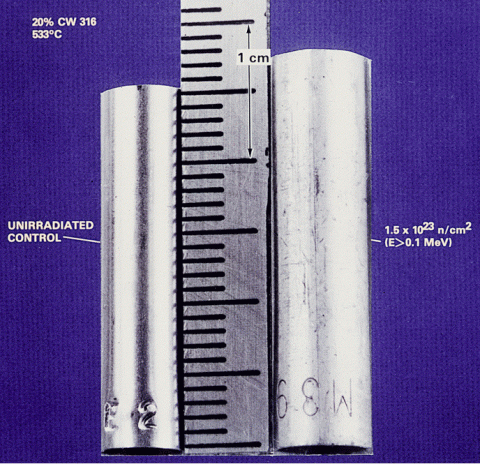
Stainless steel sample swelling under the influence of neutrons
A universal measure of how far these destructive processes go is the value of CN. - displacements per atom (or dpa in the English literature). It means how much on average each atom will have to interact with radiation. Typical values for nuclear reactors are from 5 to 60 na.
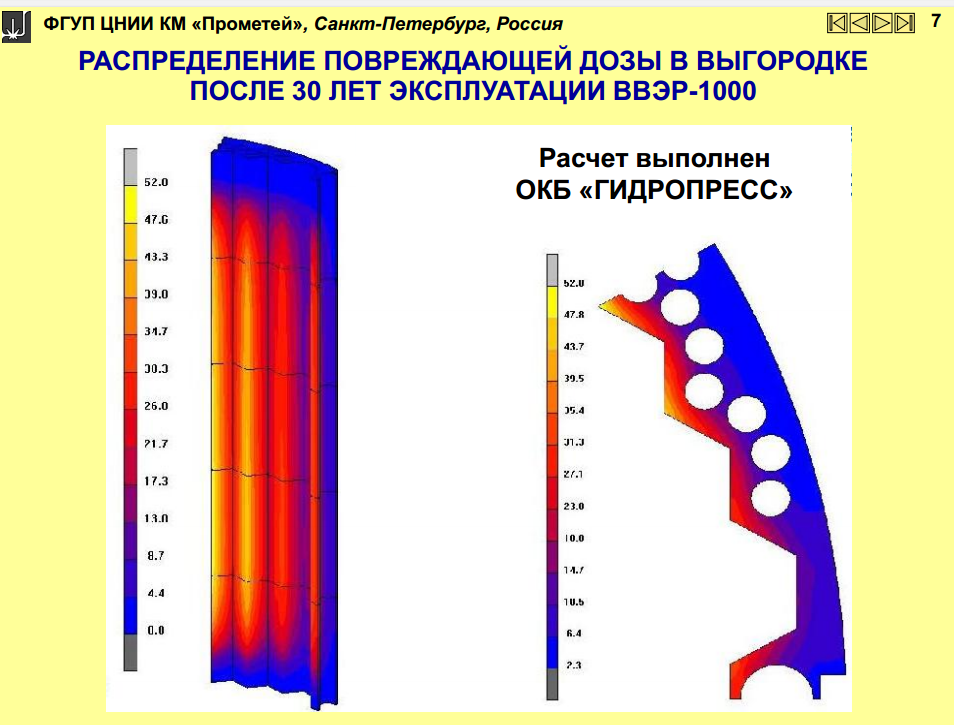
Estimated radiation damage to the WWER-1000 reactor enclosure in SN.

The impact of reactor conditions on various steel grades. EI / ES - special reactor steels.
Material scientists have invented many alloys, steels and non-metallic materials to work in such conditions. They, by the way, are often distinguished by the crazy accuracy of the composition; we are talking about an accuracy of up to 0.01% of the content of dopants. Today 60 C.N.A. is the limit for modern nuclear materials, and such materials are also limited in operating temperature, and cannot, for example, be used in hot fast reactors.

Zirconium alloys different in oxygen and iron content. Please note that the range of permissible dopant values is ~ 500 ppm, i.e. 0.05%
However, for future fast fission reactors and for fusion reactors, materials capable of standing up to 150 (and preferably up to 300) SNA are needed. without destruction, and in the case of thermonuclear - to stand not just in the neutron flux, but in the flux of super-energetic neutrons. By the way, one of the main problems of this section of materials science is the slow set of damaging doses - 20 d.n. a year in the best reactors, i.e. In order to gain 160 SN, one should leave the assembly in the reactor for 8 years.

Promising reactor materials and their irradiation program in the reactor BOR-60.
In order to create and test materials of future thermonuclear reactors, specific sources of thermonuclear neutrons are needed. Here neither high-flux research nuclear reactors, nor sputtering (accelerator) installations will be suitable. Therefore, in the 2000s, Europe and Japan adopted a program to create a special IFMIF / EVEDA research laboratory for testing promising materials.

IFMIF / EVEDA Scheme
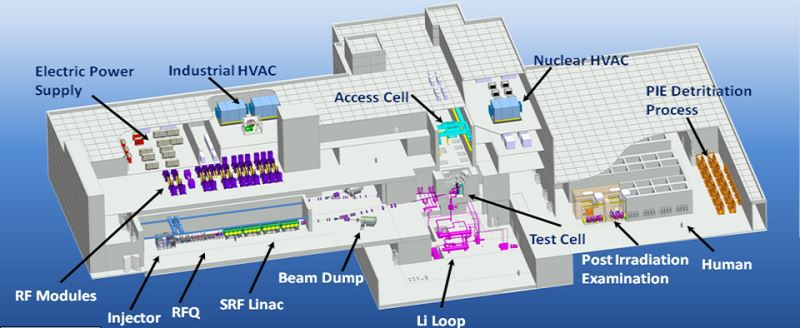
And the building plan. Find a person in this "laboratory".
The IFMIF installation consists of two small, but high-current accelerators of deuterons (deuterium ions) up to an energy of approximately 40 MeV and a lithium target (namely, a flowing stream of liquid lithium, 25 mm thick). The accelerator is quite unique in high current (125 mA), issued in a constant (rather than pulsed) mode. The accelerator consists of traditional elements - a plasma ion source, focusing systems (LEBT, MEBT, HEBT), a radio frequency accelerator module with electrodynamic ion confinement (RFQ) and a radio frequency accelerator module with electromagnetic confinement and resonator cavities (SRF Linac).
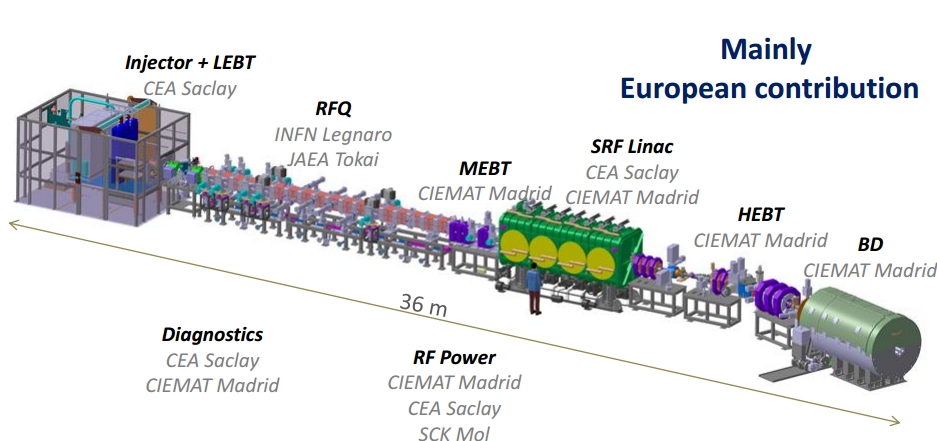
IFMIF accelerator, its elements and developers.
Accelerated deuterons from two identical accelerators interact with lithium by the reaction D + Li -> 2He + n. At the same time, the neutron formed is very similar to the thermonuclear one in its energy. The lithium target, by the way, is also a rather unique design that cleans lithium from fission products and forms a curtain target.

Lithium target circuit ...
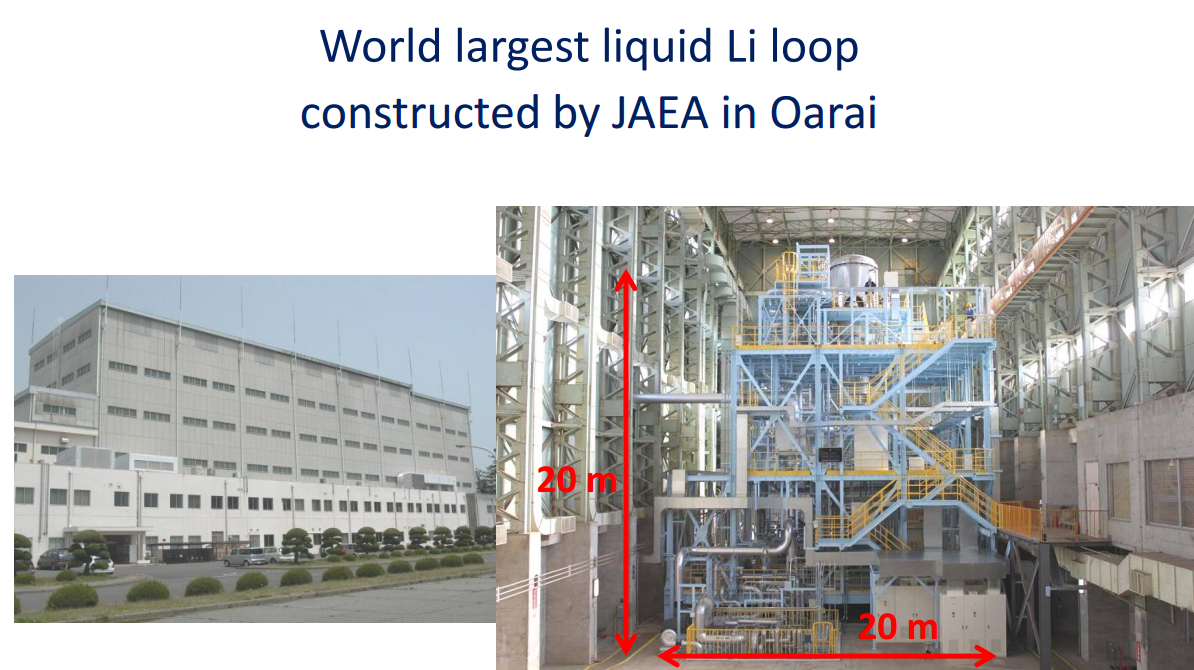
... and its life-size prototype!
The resulting neutrons arrive at a test volume, which has chambers with different neutron flux levels. A stream of 10 ^ 18 n * s / cm ^ 2 is created in the highest-intensity chamber (the volume of just half a liter, which nevertheless allows us to test many small samples at the same time) —this is 200 times more than in the most high-density nuclear reactors. There are chambers with lower intensity, which, however, allow testing already entire experimental structures with coolant, etc.

The spectral power of the neutron flux in the promising DEMO thermonuclear reactor, and the IFMIF laboratory.
The second part of the laboratory (EVEDA) is the hot cells for all kinds of research on what happened to the irradiated samples, how their mechanical, physical and chemical properties changed.
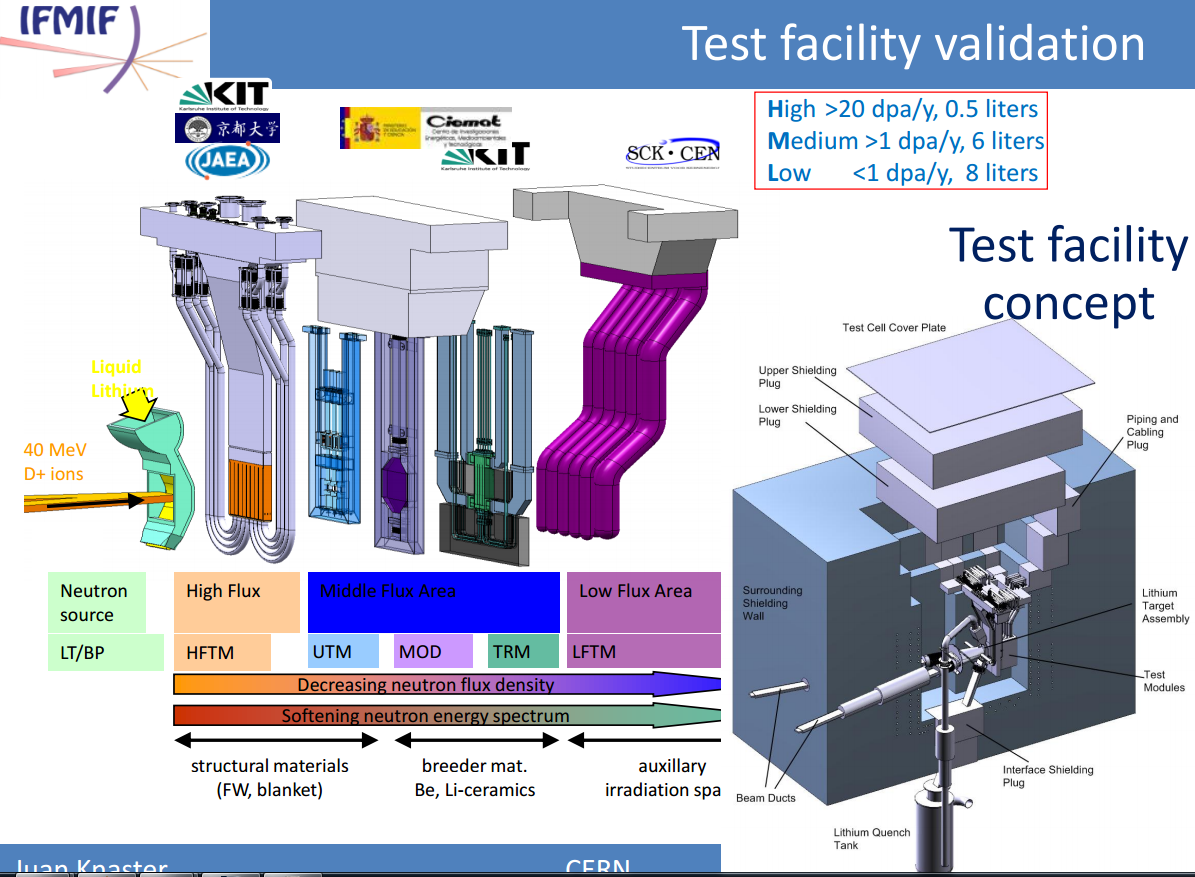
Irradiation chambers IFMIF / EVEDA At the center of the HFTM, the rate of dose of fast neutrons will be 60 sleep per year.
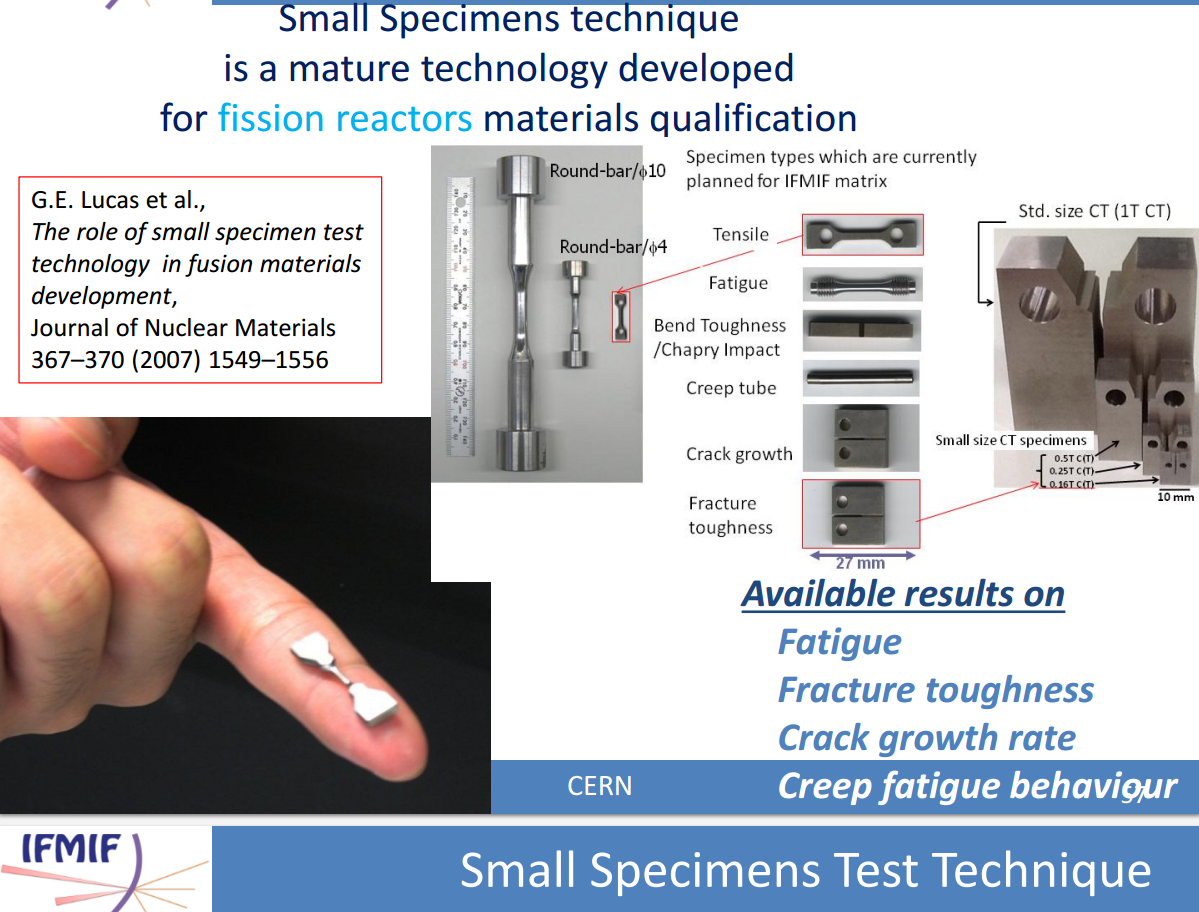
Samples of materials that will be tested in IFMIF. In total, up to 1000 such samples can be loaded into a high-flux chamber.

And about such hot cells for research of irradiated samples.
At the moment, the installation and the phased launch of the equipment are underway (for example, the accelerator’s “head”, the ion source is already being fully tested on operating modes). Installation equipment is manufactured by both European and Japanese organizations.

The building where the IFMIF / EVEDA is located in Rockasho, Japan.
After the launch of the laboratory in 2017, it will begin intensive studies of promising materials for the first wall, blanket, and other elements of the TNV that “live” in the most demanding radiation studies. Perhaps it is here that promising materials such as vanadium-titanium alloys or silicon carbide SiC will be transferred from promising to approved. If their characteristics are close to those expected, then industrial tokamaks may become noticeably closer, and many of the “paper-based” concepts of nuclear fission reactors (for example, traveling wave reactor) will become possible.

Tests for rupture of the irradiated sample in the “hot chamber”. ORLN Lab.
')
- Fast particles "break" the lattice, causing the atoms to jump over the material atoms. This leads to a decrease in ductility and increased brittleness.
- Neutrons can be absorbed by various atoms, causing their transmutation - transformation into a heavier element (for example, Fe56 + and -> Mn57). Most often, the resulting isotope is radioactive, and it disintegrates over time. This is the activation of the material - its saturation with radioactive isotopes
- These radioactive isotopes can decay to form alpha particles. Alpha particles do not leave matter, but are recombined into helium. Helium accumulates inside the material, causing it to swell and crack. Similar processes (on a smaller scale) occur with the accumulation of hydrogen, which is formed during the decay of neutrons.
- For very fast incident neutrons, a direct collapse of an atom of a structural material is possible, with the formation of many fragments and a highly radioactive residue.
- The activation of the material leads to a change in its chemical composition and various corrosion processes. Particularly difficult in places of welding and junction

Stainless steel sample swelling under the influence of neutrons
A universal measure of how far these destructive processes go is the value of CN. - displacements per atom (or dpa in the English literature). It means how much on average each atom will have to interact with radiation. Typical values for nuclear reactors are from 5 to 60 na.

Estimated radiation damage to the WWER-1000 reactor enclosure in SN.

The impact of reactor conditions on various steel grades. EI / ES - special reactor steels.
Material scientists have invented many alloys, steels and non-metallic materials to work in such conditions. They, by the way, are often distinguished by the crazy accuracy of the composition; we are talking about an accuracy of up to 0.01% of the content of dopants. Today 60 C.N.A. is the limit for modern nuclear materials, and such materials are also limited in operating temperature, and cannot, for example, be used in hot fast reactors.

Zirconium alloys different in oxygen and iron content. Please note that the range of permissible dopant values is ~ 500 ppm, i.e. 0.05%
However, for future fast fission reactors and for fusion reactors, materials capable of standing up to 150 (and preferably up to 300) SNA are needed. without destruction, and in the case of thermonuclear - to stand not just in the neutron flux, but in the flux of super-energetic neutrons. By the way, one of the main problems of this section of materials science is the slow set of damaging doses - 20 d.n. a year in the best reactors, i.e. In order to gain 160 SN, one should leave the assembly in the reactor for 8 years.

Promising reactor materials and their irradiation program in the reactor BOR-60.
In order to create and test materials of future thermonuclear reactors, specific sources of thermonuclear neutrons are needed. Here neither high-flux research nuclear reactors, nor sputtering (accelerator) installations will be suitable. Therefore, in the 2000s, Europe and Japan adopted a program to create a special IFMIF / EVEDA research laboratory for testing promising materials.

IFMIF / EVEDA Scheme

And the building plan. Find a person in this "laboratory".
The IFMIF installation consists of two small, but high-current accelerators of deuterons (deuterium ions) up to an energy of approximately 40 MeV and a lithium target (namely, a flowing stream of liquid lithium, 25 mm thick). The accelerator is quite unique in high current (125 mA), issued in a constant (rather than pulsed) mode. The accelerator consists of traditional elements - a plasma ion source, focusing systems (LEBT, MEBT, HEBT), a radio frequency accelerator module with electrodynamic ion confinement (RFQ) and a radio frequency accelerator module with electromagnetic confinement and resonator cavities (SRF Linac).

IFMIF accelerator, its elements and developers.
Accelerated deuterons from two identical accelerators interact with lithium by the reaction D + Li -> 2He + n. At the same time, the neutron formed is very similar to the thermonuclear one in its energy. The lithium target, by the way, is also a rather unique design that cleans lithium from fission products and forms a curtain target.

Lithium target circuit ...

... and its life-size prototype!
The resulting neutrons arrive at a test volume, which has chambers with different neutron flux levels. A stream of 10 ^ 18 n * s / cm ^ 2 is created in the highest-intensity chamber (the volume of just half a liter, which nevertheless allows us to test many small samples at the same time) —this is 200 times more than in the most high-density nuclear reactors. There are chambers with lower intensity, which, however, allow testing already entire experimental structures with coolant, etc.

The spectral power of the neutron flux in the promising DEMO thermonuclear reactor, and the IFMIF laboratory.
The second part of the laboratory (EVEDA) is the hot cells for all kinds of research on what happened to the irradiated samples, how their mechanical, physical and chemical properties changed.

Irradiation chambers IFMIF / EVEDA At the center of the HFTM, the rate of dose of fast neutrons will be 60 sleep per year.

Samples of materials that will be tested in IFMIF. In total, up to 1000 such samples can be loaded into a high-flux chamber.

And about such hot cells for research of irradiated samples.
At the moment, the installation and the phased launch of the equipment are underway (for example, the accelerator’s “head”, the ion source is already being fully tested on operating modes). Installation equipment is manufactured by both European and Japanese organizations.

The building where the IFMIF / EVEDA is located in Rockasho, Japan.
After the launch of the laboratory in 2017, it will begin intensive studies of promising materials for the first wall, blanket, and other elements of the TNV that “live” in the most demanding radiation studies. Perhaps it is here that promising materials such as vanadium-titanium alloys or silicon carbide SiC will be transferred from promising to approved. If their characteristics are close to those expected, then industrial tokamaks may become noticeably closer, and many of the “paper-based” concepts of nuclear fission reactors (for example, traveling wave reactor) will become possible.
Source: https://habr.com/ru/post/365991/
All Articles